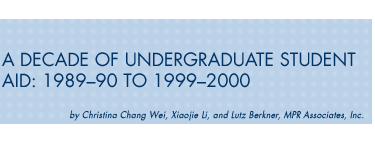The decade of the 1990s saw growth in tuition at the postsecondary level and in the amount of financial aid available, particularly student loans (U.S. General Accounting Office 1998; College Board 2002). Since public funding was constrained in the early part of the decade, tuition increases were of growing concern. At the same time, federal financial aid programs and policies as we know them today were being shaped by the 1992 Reauthorization of the Higher Education Act (HEA-92). Growth in tuition, the increased availability of federal student loans (especially unsubsidized Stafford loans), and increases in grant aid from non-federal sources were among the major driving forces of change in undergraduate student financing during this decade.
This study examines changes in many of the major aspects of undergraduate financing during the 1990s for full-time, full-year undergraduates enrolled in the four major institutional sectors located in the 50 states, the District of Columbia, and Puerto Rico: public 2-year, public 4-year, private not-for-profit 4-year, and private for-profit less-than-4-year. Tuition, total price of attendance, various net price measures, need, total aid, remaining need after aid, grants, loans, and work-study1 are compared using data from the four National Postsecondary Student Aid Studies (NPSAS2) conducted in 1989–1990, 1992–1993, 1995–1996, and 1999–2000. The main purpose of this report is to provide a convenient and readily accessible reference to the data most frequently used for trend analysis from the NPSAS surveys.
USER NOTE: This publication is best viewed using a screen resolution of at least 800x600 pixels. For instructions on how to change your screen resolution, please see NCES Help.
|



